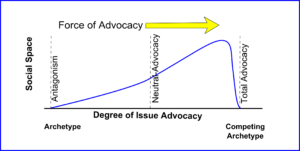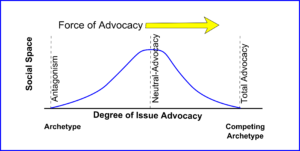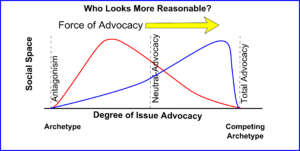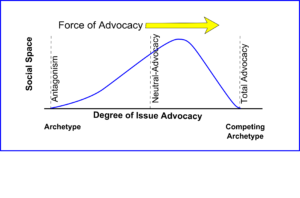Are you having difficulty getting people on your side?
Do you find yourself locked into a disagreement and never seem to get to a point where you can start having constructive dialogue with others?
Do you actually care about trying to address today’s critical problems rather than focus on winning the argument?
I want to show you an idea that illustrates how often it is the way we set up the conversation that leads us to an impasse.
My goal is to show you that with very few exceptions, we all want to make the world a better place. But too often, we enter conversations so totally imbued with the belief that we are right that we don’t make space for those who think differently. Our passionate fervor to advocate for our perspective is so great that we undervalue or discount the differing perspectives of others who stand in our way.
Total Advocacy
This is a graph of social space as a function of the degree of advocacy we wield over an issue.
 When we talk with our adversaries, many of us utilize a great deal of force in our advocacy. When we do that, when the “peak” of the advocacy graph is so far to the right, you leave very little social space for people who disagree with you. While you may think this is a good thing, particularly if you find opposing perspectives particularly loathsome, you are really undercutting your own cause. We all know that you confine things to smaller and smaller volumes, the pressure increases and the force with which your adversary pushes back at you increases immensely. The more you choose to close off the social space of your adversary, the more you empower them.
When we talk with our adversaries, many of us utilize a great deal of force in our advocacy. When we do that, when the “peak” of the advocacy graph is so far to the right, you leave very little social space for people who disagree with you. While you may think this is a good thing, particularly if you find opposing perspectives particularly loathsome, you are really undercutting your own cause. We all know that you confine things to smaller and smaller volumes, the pressure increases and the force with which your adversary pushes back at you increases immensely. The more you choose to close off the social space of your adversary, the more you empower them.
The way you “win” is not to corner them in a smaller space, it’s to invite them into a shared space with you.
Rather than opening our hearts to the possibility that the other side might have a point, some of us cast our adversaries as villains rather than potential partners in tackling problems. This never works and mostly leaves us deadlocked around issues while the increasing coarsening of rhetoric erodes social trust and makes future productive discussions less possible. This pattern, if allowed to operate, almost ensures that tomorrow will not be better than today. Indeed, it almost guarantees the opposite.
I am a person with strong opinions. Like everyone, I struggle with the temptation of indulging myself that I have all the answers and that my perspective is the right one. But, I have learned through the years, that I have a choice, I can be “right” (meaning sanctimoniously telling everyone else they are wrong) or I can be effective. I can’t be both. A good leader doesn’t have the luxury of being “right” when problems need solving. Bad leaders can engage in moral preening all day long. I try my best to be the former.
In any issue, you have the thesis (your perspective), the antithesis (their perspective), and the synthesis (the merging of these perspectives). Synthesis is the basis upon which solutions, which address the interests of all sides, emerge. But we will never get to the synthesis stage if we don’t fairly engage with the other side in the spirit of curiosity, patience, and respect.
I’ve already discussed why this is bad from having productive conversations with those with whom you disagree, but it is also important to explore this concept from an influencer perspective.
Treatment of Bystanders
Another issue that hinders your cause is the characterization of bystanders. Below is the advocacy position we all should adopt when we first become aware of an issue. These people either are still learning about your issue or haven’t decided which side to support yet, or maybe this issue is one with which they don’t have a powerful opinion.
 If you are breath away from total advocacy, when you look over your shoulder, those who are situated at the neutral spot look like they are antagonists.
If you are breath away from total advocacy, when you look over your shoulder, those who are situated at the neutral spot look like they are antagonists.
These people who might otherwise be brought onto your side find themselves placed into the warring camp by default. Congratulations, you just made more roadblocks for yourself.
Influence is a game of sustained small wins. This is a losing game.
So far we’ve seen what happens when you exhibit a high degree of issue advocacy.
The Food Fight
When partisans are constantly at each other’s throats, onlookers see a food fight.
 No one is willing to compromise. Neither side is honest, fair, or reasonable. These are two spoiled 3-year-old brats who are fighting over toys. Adults don’t indulge this behavior. They will tune them out and, possibly, when they have the opportunity, they’ll take action to get rid of both sides, so the grown-ups can start talking again. Congress, in particular, has been subject to the Curse on Both Your Houses perception for many years. It has lead to dramatic political disengagement, cynicism, and a growing disdain for political institutions. Most people no longer view government as an effective means of solving problems. Indeed, many see politicians as hell-bent on exacerbating them.
No one is willing to compromise. Neither side is honest, fair, or reasonable. These are two spoiled 3-year-old brats who are fighting over toys. Adults don’t indulge this behavior. They will tune them out and, possibly, when they have the opportunity, they’ll take action to get rid of both sides, so the grown-ups can start talking again. Congress, in particular, has been subject to the Curse on Both Your Houses perception for many years. It has lead to dramatic political disengagement, cynicism, and a growing disdain for political institutions. Most people no longer view government as an effective means of solving problems. Indeed, many see politicians as hell-bent on exacerbating them.
Who Looks Reasonable
The person who can appreciate nuance across controversy or who appears to be less ideological or less willing to ostracize others often will win converts because they seem to be more reasonable than others do.
 If you find yourself appalled by certain happenings in the world right now; and many of the people around you seem to be siding with the ones who appall you, you should realize that at least some of those people are looking at your issue and making the calculation that they are more reasonable then you are. I’ll reiterate. They are more disturbed by you than whoever is disturbing you. Some of you might be chalking that up to ignorance or moral deficiency of these individuals. But you might want to at least consider the possibility that you might be mistaken.
If you find yourself appalled by certain happenings in the world right now; and many of the people around you seem to be siding with the ones who appall you, you should realize that at least some of those people are looking at your issue and making the calculation that they are more reasonable then you are. I’ll reiterate. They are more disturbed by you than whoever is disturbing you. Some of you might be chalking that up to ignorance or moral deficiency of these individuals. But you might want to at least consider the possibility that you might be mistaken.
It’s clear that a high degree of advocacy is usually unproductive, but we still want to make a positive impact in the world. So how do we square that circle? What would be a productive way to advocate for your position?
Think Two-Thirds
I would never dissuade you from advocating for what you think is right. All I would ask is that you keep your heart open to the perspectives of others, your head open to consider the arguments of others, and be humble enough to appreciate the potential that you might be mistaken about certain things.
This is the degree of advocacy that I recommend you adopt for most things. Think 2/3’s. If you advocate this way, you will still put a great deal of energy behind your advocacy, but you will have the benefit of allowing those with whom you disagree to breathe and perhaps provide psychological safety to collaborate with you on mutually satisfying solutions.
 Remember, the vast majority of us are good people trying to make the world a better place. The way we carry ourselves as we go about striving for what we believe is right is often the measure by which we actually do.
Remember, the vast majority of us are good people trying to make the world a better place. The way we carry ourselves as we go about striving for what we believe is right is often the measure by which we actually do.

